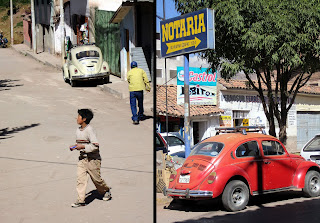Wiki tells me that:
‘The Volkswagen Type 1, widely known as the Volkswagen Beetle and Volkswagen Bug, is an economy car produced by the German auto maker Volkswagen (VW) from 1938 until 2003. With over 21 million manufactured in an air-cooled, rear-engined, rear-wheel drive configuration, the Beetle is the longest-running and most-manufactured automobile of a single design platform anywhere in the world.’
I think a great majority of the beetles that survive from that original 21 million are here in Peru
The blue beetle in these first two photos seems to be following me around. I believe it lives in the next street. I saw it first in that street, facing off against the white beetle. The next morning it was perched outside the shop on my corner, and that evening I saw it lurking up a neighbouring side street. It’s shabby but it has attitude.
I like the snazzy metallic blue of this beetle – its shiny skin shows it is obviously well cared for, though the rear bumper shows signs of a few scrapes and scratches. The words on its back windscreen, ‘solo nenas’, mean ‘only girls’. Does that mean the owner is a woman, I wonder, or maybe the owner is a playboy who only admits women to his vehicle. The orange beetle is rather garish and has on its front windscreen ‘Paz Con Dios’ – ‘Peace With God’ – perhaps the driver is hopeful of divine protection on the roads. Given the crazy drivers here and the frequency of shrines at the roadside to those killed in road traffic accidents, his plea is certainly wise.
This blue beetle was snapped quickly amongst passing traffic, while the pale green one has been parked opposite my bus stop these past two days. The woman wearing the fluorescent green vest appears to be some kind of parking warden – she collects money from the cars parked in the middle of the road. Whether this is an official position, or she is just guarding the cars from random thieves, I haven’t figured out yet.
Here we have two shades of dark green. I prefer the one on the right – it’s almost British racing green. It has a lumpy front bonnet as if it’s been in a smash and has ‘volkswagen’ on its front windscreen, as if it’s forgotten its name and needs to be reminded. The beetle on the left is parked outside the supermarket where I do my weekly grocery shop. There’s not normally such a long queue outside – I think someone was giving something away for free.
These next two beetles were photographed in the streets as I walked to my bus stop. Note the advertising posters and graffiti littering the walls behind the blue one – no city in the world seems immune to such rubbish. The red beetle reminds me of a car we had when I was a child. I liked its cheery colour but we didn’t own it long – it proved impractical for our family – when my granny accompanied us on road trips, my brother had to sit in the little space behind the back seat.
This white beetle looks pristine but white is an incredibly impractical colour in a city perpetually plagued by red dust. The beetle on the right is a jaunty Rudolf red, though its tyres look too worn to be safe.
Red is obviously a popular colour as here is another. Perhaps it belongs to the Notaria, whose sign it sits beneath. The colour does resemble the red of a notary’s seal. And the colour of the beetle at the left seems a cross between the colours of the boy’s jumper and the man’s shirt – a pale greenish-yellow. Note that most of these beetles have roof racks – a functional solution to the limitations of the beetle’s storage capacity!
The Volkswagen Beetle must be one of the most recognisable cars in the world, and I find something comforting about them. I hope you’ve enjoyed looking at these blasts from the past as much as I enjoyed photographing them.













